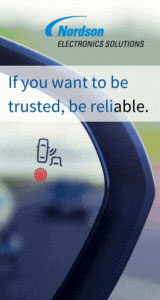|

|
|
| Ask the Experts | |||||||
|
|||||||
|
November 5, 2024 - Updated June 11, 2014 - Originally Posted Production Floor Temperature and Humidity LoggersEarly this month we had a customer audit. One of the findings regards the environment measurements in our assembly area. They noted that we only have one temperature/humidity logger and it was considered inadequate given the size of our production floor. Isn't one temp/humidity logger per facility adequate? If we add additional temp/humidity loggers, where should we place them? Near machines, near the center of production area, in the four corners? M.R. |
|||||||
| Expert Panel Responses | |||||||
|
Wouldn't it make sense to put temp/humidity monitors in critical locations, such as board and component storage areas, near the solder paste stencil printer, near the functional and in circuit test areas, and any where assemblies are staged that would sit for more than a few hours.
President/Senior Technical Consultant Foresite Mr. Munson, President and Founder of Foresite, has extensive electronics industry experience applying Ion Chromatography analytical techniques to a wide spectrum of manufacturing applications.
Temperature and humidity can effect ESD, MSD, screen printing, working time, and shelf life. If you don't measure/monitor all the multiple areas, you'll never be able to prove you don't need to.
M.O.L.E. Line Product Manager Electronic Controls Design, Inc. (ECD) Mark Waterman is a trainer and field engineer with 17 years experience in service and applications specialties. Intimate knowledge of soldering processes and measurement systems. Six sigma and statistical process control generalist.
Whether one logger is enough is entirely dependent on the facility. In facilities where airflow into/out of the facility is tightly controlled, and the facility is under slight "positive pressure" with more make-up air than exhaust, one logger might in fact be enough. In many facilities, especially older ones, we don't have this luxury. How many loggers we need, and where we place them will depend on a number of variables. Some of these are:
Correlate your temperature and humidity data with the outside temperature and dew point. The outside dew point is an incredibly important factor, and is the one variable that drives out-of-control conditions on the shop floor more often than any other, in my experience.Once you know where your "sensitive spots" are, you can add loggers to keep track of them. On most moderate-sized production floors, I don't see a big benefit to more than three loggers, in most cases.
Process Engineer Astronautics Fritz's career in electronics manufacturing has included diverse engineering roles including PWB fabrication, thick film print & fire, SMT and wave/selective solder process engineering, and electronics materials development and marketing. Fritz's educational background is in mechanical engineering with an emphasis on materials science. Design of Experiments (DoE) techniques have been an area of independent study. Fritz has published over a dozen papers at various industry conferences.
One should not challenge an auditor, however it would be fair to ask, what standard indicates that more than one temperature/humidity instrument is required. IPC standards (J-Std 001) recommend you control the temperature and humidity, but they do not tell you how. However, rule of thumb can apply here. One question to ask yourself: How many HVAC system control thermostats are in the same area/facility? It would be fair to suggest that you should have the same number of temperature/humidity measurement instruments in that same area/facility. Another rule of thumb is one temperature/humidity instrument per 10,000 square feet of floor space. As for where to place them, this is simple: where people and product spend the most amount of time. The whole point of measuring the temperature and humidity is to document that people and product are NOT being subjected to extremes. So place instruments where the action is: on the line, in or near the machines, etc.
Senior Project Engineer Electronic Controls Design Inc Paul been with Electronic Controls Design Inc. (ECD) in Milwaukie, Oregon for over 39 years as a Senior Project Engineer. He has seen and worked with the electronic manufacturing industry from many points of view, including: technician, engineer, manufacture, and customer. His focus has been the design and application of measurement tools used to improve manufacturing thermal processes and well as moisture sensitive component storage solutions.
First & foremost..."your customer audit" They are making the request. Customers are hard to come by. Monitors are relatively inexpensive. You do not indicate the size of your facility so an accurate answer is difficult. A monitor at the center of your facility is ideal but it will not provide accuracy of readings at the far corner, say near your reflow line or your washing system. Humidity will generally be different in various areas of your facility. The question itself raises these questions... are you controlling humidity currently? Where are you located? A high humidity area... Florida? A low humidity area... Arizona? There are wireless units on the market now that can mo niter locations & report back to one central PC. This provides facility wide reading with automated recording of the factors required.
President JSK Associates Based in. Northern California since 1971. Founded JSK Associates in 1979. Actively involved in soldering, cleaning, chemistries. 30 years experience in EOS/ESD control.
Humidity and temperature monitored areas are areas where these parameters can possibly impact the process yields and or quality. Some areas that are normally monitored are:
Senior Market Development Engineer Kester Mr. Biocca was a chemist with many years experience in soldering technologies. He presented around the world in matters relating to process optimization and assembly. He was the author of many technical papers delivered globally. Mr. Biocca was a respected mentor in the electronics industry. He passed away in November, 2014.
The answer is dependent on the uniformity of the temperature and humidity within the room or on the factory floor. Large areas are subject to variations in temperature if the air handlers are not positioned properly or correctly balanced. A common mistake is locating temperature/humidity monitors within the near draft path of an air conditioner vent. Ideally, before stationing any temperature/humidity monitors, the room will be mapped especially for temperature uniformity. Influences of operating equipment,the number of people present, outside environment, wind conditions, opening and closing doors, consistency of air conditioner output, exhaust stack vent motors on and off, among other factors, can all impart changes to the environment. Even after such mapping and impact studies, I always encourage deployment of multiple recording temperature/humidity monitors; one in the center and at least a couple at extreme opposite corners or a large room or factory floor. Frequent and routine monitoring of the temperature/humidity graphs is a must to understand environmental impact on materials and ensuing quality.
President Colab Engineering A thirty year veteran of electronics assembly with major OEMs including Digital Equipment Corp., Compaq and Hewlett-Packard. President of Colab Engineering, LLC; a consulting agency specializing in electronics manufacturing, root-cause analysis and manufacturing improvement. Holder of six U.S. process patents. Authored several sections and chapters on circuit assembly for industry handbooks. Wrote a treatise on laser soldering for Laser Institute of America's LIA Handbook of Laser Materials Processing. Diverse background includes significant stints and contributions in electrochemistry, photovoltaics, silicon crystal growth and laser processing prior to entering the world of PCAs. Member of SMTA. Member of the Technical Journal Committee of the Surface Mount Technology Association.
|
|||||||
| Submit A Comment | |||||||
|
Comments are reviewed prior to posting. You must include your full name to have your comments posted. We will not post your email address. |
|
Free Newsletter Subscription
Circuitnet is built for professionals who bear the responsibility of looking ahead, imagining the future, and preparing for it. Insert Your Email Address |
|

|









